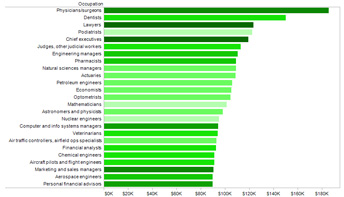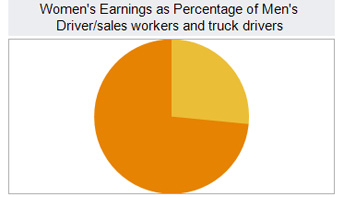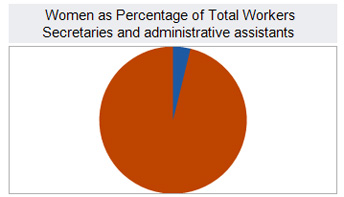December 21, 2010 — Last week, the Census Bureau released, for the first time, 5-year data from the American Community Survey (2005 to 2009). In addition to basic population data, the release provides a snapshot of a vast array of social and economic indicators. These include occupational data broken down by gender.
There remain striking differences between men and women: some occupations are highly dominated by men; others are highly dominated by women. In general, the median wages in the jobs dominated by men are higher than in those dominated by women. Within a single occupation, median pay for men almost always exceeds that for women, often by a substantial amount.
These data visualizations allow one to see and sort by median earnings, by total number of workers, by percentage of total workers who are women, and by the median earnings of women as a percentage of the median earnings of men.
Please note: these data visualizations can only be properly viewed on monitors with resolutions of 1600 x 1200 (or better) due to the large amount of information displayed.
Top 25 occupations by median earnings of men
In each of these occupations, women workers are no more than 50 percent of the total; in 10 of these occupations, women workers are no more than 20 percent of the total.
In all but two cases, median earnings of women were less than 90 percent than those of men.
To view the data visualization, click on the image or click here.
Occupations with more than 90 percent men and more than 100,000 total workers
The ACS data reflect more than 100 occupations where men are more than 90 percent of the workers. This data visualization is limited to those where the total number of persons employed in the occupation is over 100,000.
There are 20 of these occupations where the median earnings of men is $40,000 or more a year. In every single case, the median earnings of men exceed those of women, with median earnings for women being less than 90 percent those of men in 21 of the 35 occupations at issue.
To view the data visualization, click on the image or click here.
Occupations with more than 75 percent women and more than 100,000 total workers
If one examined occupations with more than 90 percent women and more than 100,000 workers, there would only be six such occupations (as compared with 35 for men). Remapping Debate used less stringent measure of occupational domination — greater than 75 percent women — to yield the 30 occupations depicted in this data visualization.
In each and every one — whether large occupations like secretaries or teachers, or smaller occupations like payroll and timekeeping clerks — median earnings of women were less than those of men, although women did have median earnings in excess of 90 percent of those of men in several occupations.
In five cases — including registered nurses and elementary and middle school teachers — median pay for women was $40,000 or more a year (compared with 20 such occupations for men).
The highest median for women is that of registered nurses ($59,499). There were four occupations with more than 100,000 workers in total that had median incomes for men that were higher (including engineering managers and construction managers).
To view the data visualization, click on the image or click here.


